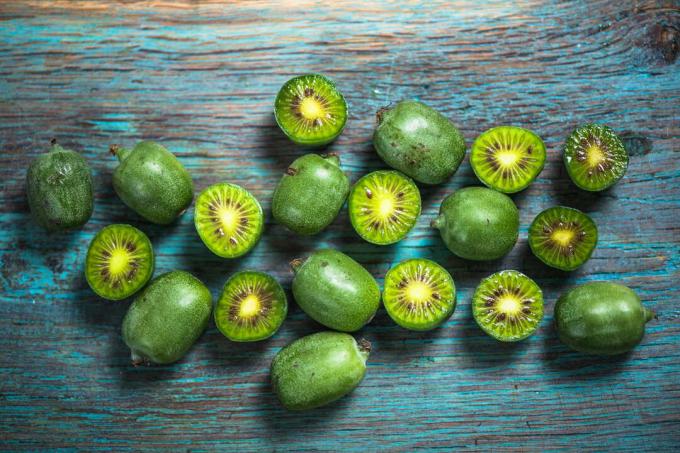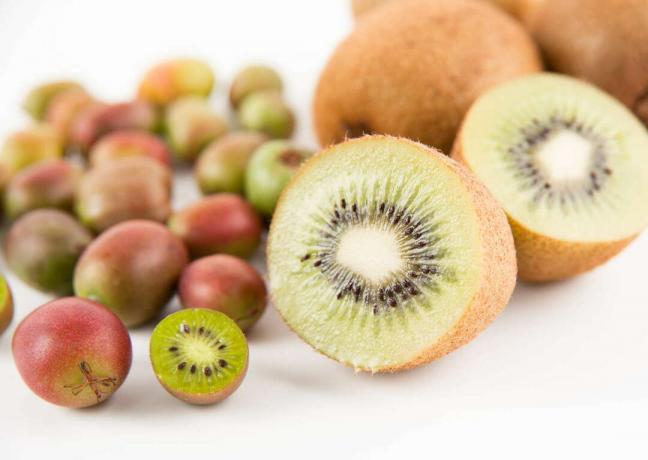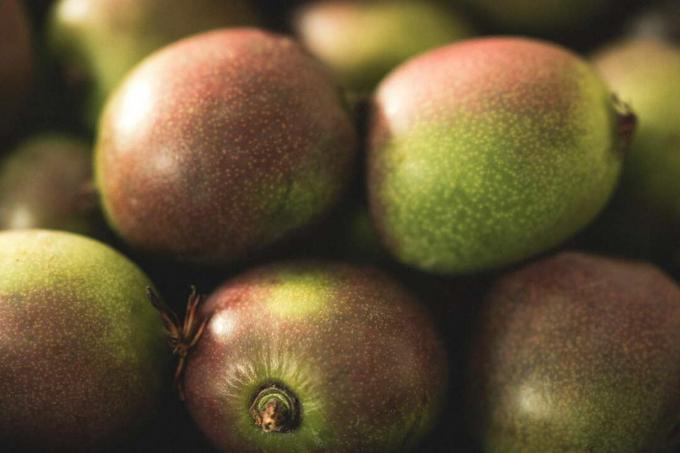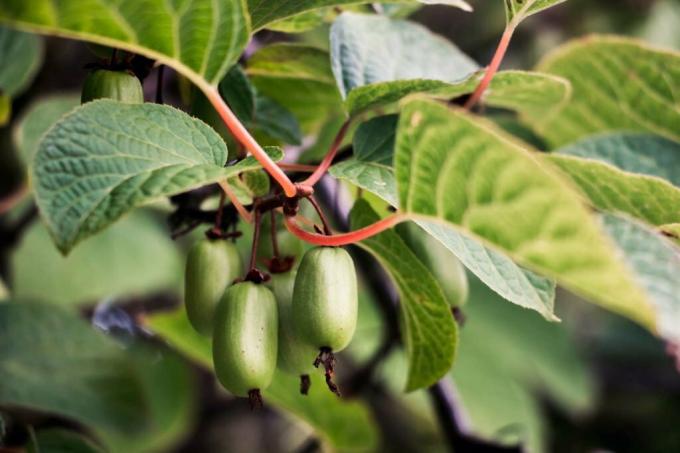The new superfruit from Southeast Asia is reminiscent of a mini kiwi. We show what you have to consider when planting and caring for the kiwi berry.

When you hear "kiwi", you usually think of the egg-sized kiwi fruit with a furry, brown skin. But that there are over 100 species of kiwi (Actinidia) only very few people know. The commercial kiwi (Actinidia deliciosa) is only one of these 100 species, but most of them are so-called kiwi berries (Actinidia arguta) and are very different from the conventional kiwi. For example, kiwi berries are much more frost-resistant than these. The extremely high-yielding, undemanding plants can therefore be grown in our gardens without any problems. In this article you will find out where the kiwi berry comes from and what to consider when choosing the variety, planting and caring for the mini kiwi.
contents
- Mini kiwi: origin and characteristics
- Mini kiwi varieties
- Buying Mini Kiwi: Expert Tips and Where to Buy
- Plant mini kiwi
- Caring for mini kiwi
- Harvest and store mini kiwi fruit
- Using the mini kiwi
Often referred to as the “little sister of the kiwi”, the kiwi berry has many names: it is also called grape kiwi, Chinese gooseberry, honeyberry, kokuwa, kiwai or small-fruited kiwi. We know it mainly under the name "Mini-Kiwi". Both the kiwi and the kiwi berry belong to the ray fruit family (Actinidiaceae). However, kiwi berries are much smaller than kiwi fruit and have a smooth, edible skin. Outwardly, the mini kiwi is most likely to resemble one Gooseberry (Ribes uva-crispa). However, the sweet and sour wild fruit taste has little in common with gooseberries.

Mini kiwi: origin and characteristics
Kiwi berries come from eastern Asia. There they grow up the trees like lianas. For some years now, mini kiwis have been grown commercially in southern Europe, but are still rarely found in supermarkets. It is all the more appealing to grow the superfruit yourself in the garden. Kiwi berries are large, woody climbing plants that are green in summer. These loopy climbers can grow up to 6 meters in height. From April kiwi berries bloom with small, creamy white flowers in sham umbels. The fruits can finally be harvested in September and October. The delicious vitamin bombs can take on a wide variety of shapes and colors: Round to oblong, green, yellow-green, light or dark red. Almost all varieties of mini kiwi are dioecious, which means that each plant only bears male or female flowers. Only the female plants bear fruit. In order to ensure the fertilization of the flowers, both female and male specimens must be grown in the garden.
Tip: How can male and female plants be distinguished from one another? You can do this using the flowers. The flowers of the female plants are surrounded by a wreath of stylus arranged in rays. Male flowers, however, do not have this wreath.

Mini kiwi varieties
There are varieties of kiwi berries in abundance. The varieties' Julie ','Issai‘And 'Cinderella', which are small and bear fruit from the first year after planting, are recommended. With all other varieties, you have to wait until the third year to harvest the first fruits. We have put together for you which varieties are still suitable for cultivation in your garden. Note: All of these varieties are hardy.
Fruiting mini kiwi varieties:
- ‚Weiki‘: This variety is also called Bavaria kiwi and is probably the best-known of the berry kiwi varieties. 'Weiki' kiwi berries are productive and robust
- ‚Red jumbo‘: As the name suggests, the pulp and skin of this variety are dark red to purple. The fruits are sweet and juicy. Harvest in late autumn
- ‚Julie‘: This variety from Saxony is very productive. The taste of the small, dark green fruits is strong and aromatic
- ‚Red Potsdamer‘: This variety is very robust and, as the name suggests, comes from the garden of Sanssouci Palace in Potsdam. The fruits are green on the inside, the skin is light red
- ‚Cinderella‘: The berries of this variety are light green, oval and have a high vitamin C content. Very productive
- ‚Bojnice‘: The fruits of the 'Bojnice' kiwi berries look like small apples. They taste sweet and aromatic

Twitter mini kiwi varieties:
- ‚Issai‘: This variety bears small, green, elongated fruits. 'Issai' kiwi berries are self-fertilizing
- ‚Jassai‘: This variety of kiwi berries has a very high vitamin C content. The plant is very vigorous, productive and the fruits are light green and sweet. In addition, this variety is self-pollinating
Fertilizing mini kiwi varieties:
- ‚Amandus‘: This variety is suitable as a pollinator for all mini kiwi varieties
- ‚Milano‘: The male plants of this variety are also well suited as pollinators for all female mini kiwi plants
Buying Mini Kiwi: Expert Tips and Where to Buy
When buying a kiwi berry plant, you should make sure that it is free from pests and diseases and that it looks healthy. The variety of mini kiwi should also be decisive for the purchase: Is it not self-fertilizing such as 'Issai', then you should add one male for every six female plants to buy.
With a bit of luck, you can find kiwi berry plants in the garden center or hardware store near you. Since kiwi berries are still quite unknown to us, it is advisable to order through an online dealer. There you will find a large selection of different varieties. We have put together a selection of online retailers for mini kiwifruit for you.
deaflora.de: The "aroma nursery" has over 3,300 plants and seeds on offer. Including a very large selection of mini kiwis.
Kiwiri.de: The online specialist shop especially for kiwi berries. Here you can buy all sorts of organic mini kiwifruit.
olerum.de: Here owner-managed garden centers have come together and operate a joint online shop. Seeds and plants are offered for sale, including some types of kiwi berries, some of them organic.
wildobstschnecke.de: The company from the Ore Mountains is committed to the sale of wild and berry trees. In the assortment you will find a very large selection of different mini kiwis.

Plant mini kiwi
Mini kiwis can be planted in spring, as soon as there is no more frost. To do this, choose a sunny to partially shaded location near the trees.
When planting the kiwi berry, do the following:
- Loosen the soil well and work in humus
- Dig the planting hole
- Put the plant in
- Fill the planting hole with compost and excavated material
- Water well
- Spread the mulch layer
The planting distance for mini kiwis should be 2 meters. As typical climbing plants, the kiwi berries also look forward to a climbing aid in the form of a trellis or a pergola.
Detailed information on the Planting the mini kiwi You will find here.
Caring for mini kiwi
Once the kiwi berry is planted, it is extremely easy to care for. However, you shouldn't neglect watering, especially on hot summer days. From the second year onwards, the mini kiwi will also be happy to receive fertilizers on a regular basis. We recommend an organic fertilizer such as compost, animal manure or ours Plantura organic universal fertilizer with organic long-term effect, which optimally and long-term supplies the mini kiwi with all the important nutrients. However, so that the vigorous plant does not overgrown your garden and the yield is increased, a regular cut of the mini kiwi is necessary.
Exact Care tips for the kiwi berry we have compiled for you here.
Harvest and store mini kiwi fruit
In autumn, from September to the end of October, the mini kiwis are ripe and can be harvested. Whether the fruits are ripe is shown by the fact that - depending on the variety - they become reddish or light green and soft. It is best not to harvest each fruit individually, but always the whole vine. This way the skin does not break and the delicious fruits have a longer shelf life.
If the harvested kiwi berries are still too hard after the harvest, you can let them ripen for two to three weeks at room temperature. Ripe mini kiwifruit stay fresh in the refrigerator for up to three weeks. If you want to store the super fruits longer, you can also freeze them without hesitation.
Using the mini kiwi
Due to their high vitamin C and E content, the delicious, fruity taste and the low calorie content, mini kiwis can rightly be described as super fruits. They are best eaten fresh and with the skin on. You can also use the sweet fruits to bake cakes and tarts, boil them down to make jam and compote, or use them to make juice. Fresh kiwi berries are also very tasty with yoghurt or in muesli.
More healthy Fruits with a lot of vitamin C. can be found in this overview.



